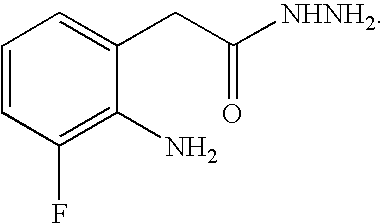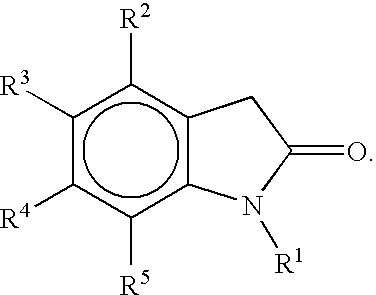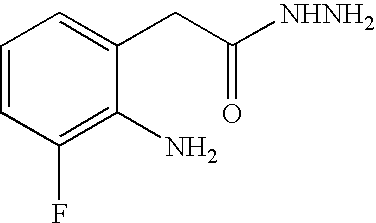Process for the synthesis of progesterone receptor modulators
- Summary
- Abstract
- Description
- Claims
- Application Information
AI Technical Summary
Benefits of technology
Problems solved by technology
Method used
Image
Examples
example 1
Preparation of 7-Fluoro-1,3-dihydroindol-2-one
[0083] To a mixture of 7-fluoro-1H-indole-2,3-dione (100 g, 0.606 mol) in ethylene glycol (500 mL) was added an aqueous hydrazine solution (54% wt, 73 g, 1.21 mol) dropwise over 30 minutes. The mixture was heated to 120° C. and stirred for 6 hours. The mixture was cooled to room temperature and water (500 mL) was added. Concentrated hydrochloric acid (HCl; 60 mL) was added, the mixture was warmed to about 35 to about 40° C., and the mixture was stirred for 1 hour. The mixture was then cooled to about 0 to about 5° C. The solid compound was filtered, washed with cold water and dried at 55° C. under vacuum to give an off-white solid (76 g) in 83% yield with 96% HPLC purity.
example 2
Preparation of 5-Bromo-7-fluoro-3,3-dimethyl-1,3-dihydro-indol-2-one
[0084] To a stirred slurry of potassium t-butoxide (t-BuOK-370 g, 3.30 mol) in tetrahydrofuran (THF; 1300 mL) was added a slurry of 7-fluoro-1,3-dihydroindol-2-one (100 g, 0.660 mol) in THF (1000 mL), followed by the addition of CuBrMe2S (14 g, 0.070 mol). Methyl iodide (260 g, 1.83 mol) was then added dropwise to the mixture at about 5 to about 15° C. The reaction mixture was stirred for at least 20 minutes at 25° C. A solution of 24% ammonium chloride (NH4Cl-141 g, 2.64 mol) in water (600 mL) was added to the reaction mixture. The organic layer was separated and washed with water (700 mL). The combined aqueous washes were extracted with t-butyl methylether (1000 mL). The combined organic layers are washed with brine (600 mL) and then concentrated by distillation. Acetic acid (869 mL) was then added and the mixture was concentrated under atmosphere pressure to a volume of about 650 mL.
[0085] To the stirred acetic...
example 3
Preparation of 5-(7-Fluoro-3,3-dimethyl-2-oxo-2,3-dihydro-1H-indol-5-yl)-1-methyl-1H-pyrrole-2-carbonitrile
[0086] A mixture of 5-bromo-7-fluoro-3,3-dimethyl-1,3-dihydro-indol-2-one (100 g, 0.387 mole), 5-[1,3,6,2]Dioxazaborocan-2-yl-1-methyl-1H-pyrrole-2-carbonitrile (110 g, 0.252 mole), sodium carbonate (Na2CO3; 49.2 g, 0.233 mol), THF (2 L), water (0.5 L), and PdCl2(PPh3)2(2.72 g, 3.9 mmol) was heated to 65° C. for 2 hours. The solution was then cooled to room temperature and a saturated sodium chloride solution (1.0 L) was added.
[0087] The organic phase was then isolated, N-acetyl-L-cysteine (31.7 g, 0.194 mol) was added, the mixture was heated to 65° C. for 1 hour and then cooled to room temperature. The cooled mixture was filtered through a glass-sintered funnel packed with the Celite® reagent (100 g) and charcoal (50 g). The filtrate was concentrated by distillation to a volume of about 300 mL and ethanol (EtOH; 500 mL) was added to the slurry. The mixture was distilled to a...
PUM
 Login to View More
Login to View More Abstract
Description
Claims
Application Information
 Login to View More
Login to View More - R&D
- Intellectual Property
- Life Sciences
- Materials
- Tech Scout
- Unparalleled Data Quality
- Higher Quality Content
- 60% Fewer Hallucinations
Browse by: Latest US Patents, China's latest patents, Technical Efficacy Thesaurus, Application Domain, Technology Topic, Popular Technical Reports.
© 2025 PatSnap. All rights reserved.Legal|Privacy policy|Modern Slavery Act Transparency Statement|Sitemap|About US| Contact US: help@patsnap.com



